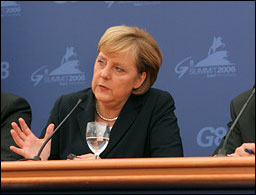Michael Levitin is a freelance writer based in Germany. Last week, he attended KyotoPlus: Escaping the Climate Trap, an international conference held in Berlin.

Monday, 2 Oct 2006
Berlin, Germany
Imagine a trans-European “super grid” of renewable energy connecting solar parks in northern Africa to wind farms in Scandinavia. Consider the millions in savings — in miles, in dollars, in tons of CO2 injected into the atmosphere — if once a week, one out of every 10 Americans telecommuted to work using state-of-the-art conference screens at home.
Or how about picturing the alternative: a world in which our continued burning of fossil fuels forces global temperatures over the 2 degree Celsius threshold (we’re currently 0.7 degrees C above pre-Industrial levels) believed to be the tipping point that will lead to long-term, devastating atmospheric changes.
These were a few of the starkly opposing scenarios laid out by scientists, politicians, activists, and businesspeople at last week’s international conference held in Berlin, called “KyotoPlus: Escaping the Climate Trap.” With the original Kyoto Protocol and its modest rules on carbon cuts set to expire in 2012, energy and policy experts across the developed world are hustling to lay out conditions for a new, comprehensive climate-protection policy. It’s fitting that the gathering took place in Germany, the country scheduled to take over the rotating seats of both the European Union and the G8 nations in 2007 — and where Chancellor Angela Merkel last Thursday vowed to make tackling climate change a top priority of her European chairmanship.
“[The future] is about making sharp cuts. It’s about restructuring our lives, re-steering investment, shifting our modes of transportation and production,” Renate Künast, a Green Party politician and former agriculture minister, told the 600-strong crowd packed into the glass, solar-powered Energy Forum building located on the Spree River, just yards from the longest standing stretch of the Berlin Wall. Young, charismatic, and a shrewd politician, Künast is the kind of firebrand leader the environmental movement needs, here and elsewhere. Damning the EU’s failed cap-and-trade system within the Kyoto Protocol, whose loopholes allowed industrial carbon emissions to keep soaring, she called on her country to much more aggressively lead the way in Europe. “Germany must be a pioneer. We need a green market economy where only sustainable use is an acceptable use. Count on technological change,” Künast warned, “because by the middle of the century, we’ll need an economy that runs carbon-free.”
How we reach that carbon-zero goal, though, is where the Germans and other Europeans differ decidedly from the Americans in their approach to climate change. It’s as though, at a conference like this one, two opposing strategies are simultaneously at play: there’s the European camp, attempting to centralize a common energy policy (such as a follow-up treaty to Kyoto) based on universally agreed-upon emission cuts and a continent-wide plan for renewable fuel distribution, versus the American one, where energy policy is driven by a fragmented, state-by-state patchwork of strategies and no unifying law.
“At the end of the day, climate is about energy technology, and in the U.S. it’s the states who are taking the lead on energy policies,” Lewis Milford, president of the Vermont-based Clean Energy Group, said at a panel he chaired with California Energy Commissioner John Geesman, Massachusetts Rep. Jim Marzilli (D), and other clean-fuel advocates from the U.S., who shared some surprising results of their regional energy plans. In Connecticut, for example, an NGO called SmartPower is marketing clean energy through competitive community programs; in Oregon, energy efficiency saves the state 1 million megawatt hours per year; in the Northeast, nine states have signed on to the Regional Greenhouse Gas Initiative, agreeing to cut CO2 emissions by 10 percent. And in California, according to Geesman, Gov. Arnold Schwarzenegger’s aim to increase renewable-electricity generation to 20 percent of the state’s total by 2010 — and, even more ambitious, to possibly 33 percent by 2020 — backs up a recent poll that found 85 percent of Californians want the state to double its reliance on clean energy over the next decade.
“Germany has become complacent as a leader in climate change,” said Marc Berthold of the Heinrich Böll Foundation, one of a handful of NGOs that helped organize KyotoPlus. It was Germany, after all, that in 2001 established the Renewable Energy Sources Act, whose successful feed-in tariff model has been adopted by countries from China to Spain. Germany is still the world’s largest wind power producer, the second largest solar producer, and it is planning to subsidize its renewables industry to the tune of $60 billion to $70 billion over the next decade — a figure that dwarfs U.S. renewable energy subsidy plans per capita by comparison. Nevertheless, “Germany needs to learn from and be encouraged by policies elsewhere,” Berthold added. “If the U.S. said, ‘We want to be better than Germany by reducing emissions, say, 30 percent by 2030,’ that would be great. The competition would help us.”
One thing people in Europe seem to agree on is that the growth and trade of renewable forms of energy, including their spread to the developing world, must not be seen as a national resource with national boundaries but as a continental — even a transcontinental — resource whose widest expansion benefits us all. In Germany alone, the signs of ecological decline are all too obvious: rainfall deficits, soils suffocating in nitrogen, swaths of forest killed off by the bark beetle, vast tracts of fruit trees withering from disease. So, as the world receives the fourth report by the Intergovernmental Panel on Climate Change early next year, Germany will take charge of the European Union and the Group of Eight with the chance to lead the effort to make the most binding commitments to cutting carbon emissions ever, speculated to be as high as 40 percent by 2020.
Then, of course, comes the other big question: will America and the industrialized nations — not to mention China, India, Brazil, and others — follow? According to Jerome Ringo, president of the 22 million-member Apollo Alliance, who spoke with a resounding, preacher-like intensity at the conference, the answer is a simple “yes.”
“The people of America want to see an answer to climate change. The people of America want to see a reduction in CO2,” he said, his voice bellowing through the bright, sunlit conference hall. “I challenge you: help us save the planet. It is not a question of should we. We must.”


